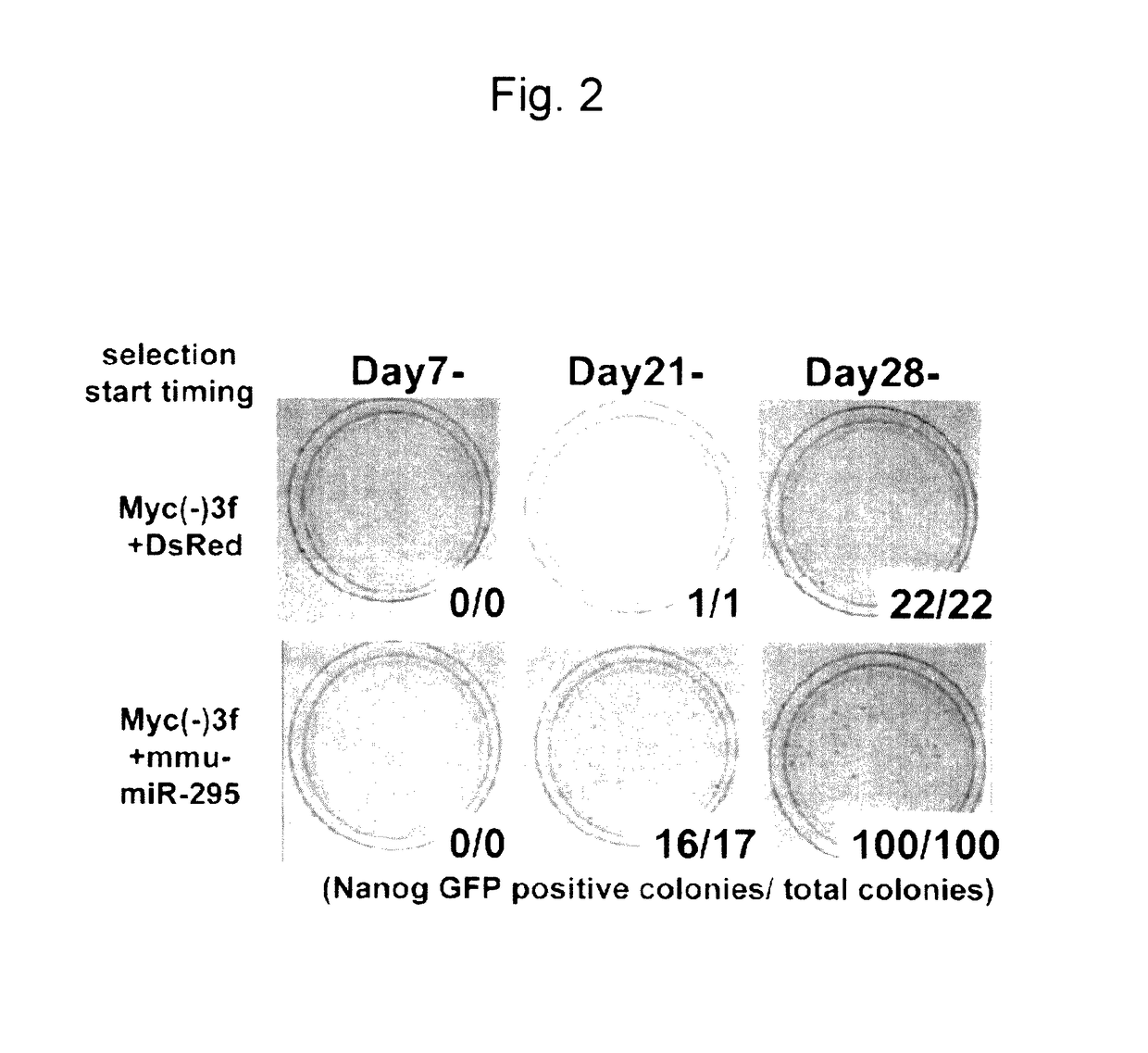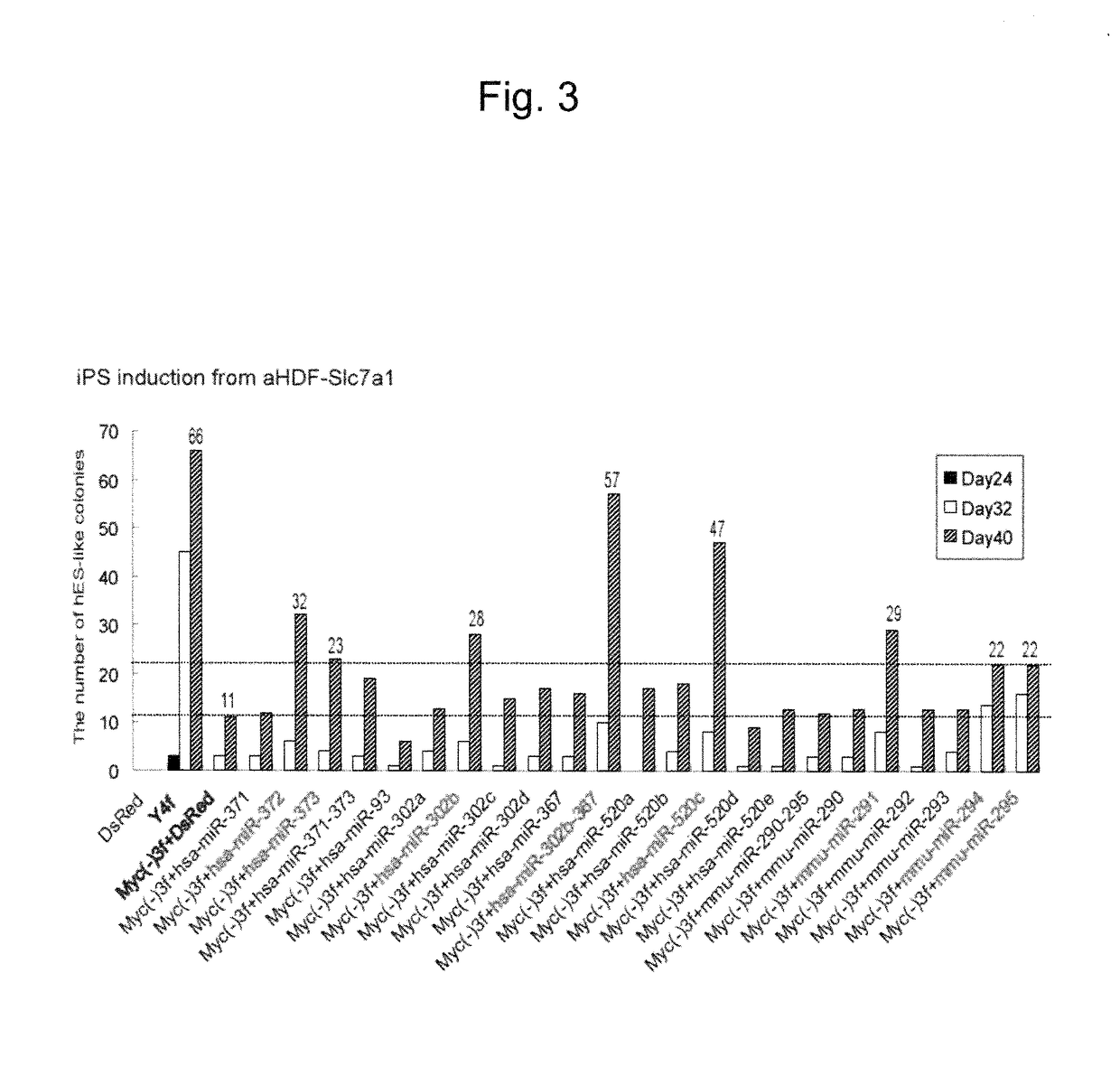Efficient method for nuclear reprogramming
a nuclear reprogramming and efficient technology, applied in the direction of cell culture active agents, non-embryonic pluripotent stem cells, genetically modified cells, etc., can solve the problems of low production efficiency low efficiency, and small number of induced pluripotent stem cells, etc., to achieve efficient preparation, efficient preparation, and efficient preparation
- Summary
- Abstract
- Description
- Claims
- Application Information
AI Technical Summary
Benefits of technology
Problems solved by technology
Method used
Image
Examples
example 1
on of Induced Pluripotent Stem Cells Through Nuclear Reprogramming of Mouse Embryonic Fibroblasts
[0152]pMXs-based retroviral vectors, which respectively encode each of three genes of mouse-derived Oct3 / 4, Sox2, and Klf4, control DsRed or each miRNA of 18 types of miRNAs, were transfected into PLAT-E cells using FuGENE 6 reagent (Roche) to get retroviruses. On the next day, embryonic fibroblasts (Nanog GFP MEF, WO2007 / 069666 A1) derived from transgenic mice generated by insertion of sequences encoding EGFP gene and puromycin resistance gene downstream of a Nanog gene promoter region, were seeded at 1×105 cells / well in 6-well plates. On the next day, these cells were infected with retroviruses expressing Oct3 / 4, Sox2, Klf4, and each type of miRNA selected from 18 types of miRNAs, at a ratio of 1 ml of virus mixture expressing these three factors to 1 ml of virus solution expressing miRNA or DsRed, so as to prepare induced pluripotent stem cells through nuclear reprogramming.
[0153]
TABL...
example 2
on of Induced Pluripotent Stem Cells Through Nuclear Reprogramming of Mouse Tail Tip Fibroblasts
[0155]pMXs-based retroviral vectors, which respectively encode each of three genes of mouse-derived Oct3 / 4, Sox2, and Klf4, DsRed (control), or mmu-miR-295, were transfected into PLAT-E cells using FuGENE 6 reagent (Roche) to get retroviruses. On the next day, tail tip fibroblasts (Nanog GFP tailtip fibroblasts) derived from transgenic mice generated by insertion of sequences encoding EGFP gene and puromycin resistance gene downstream of a Nanog gene promoter region, were seeded at 1×105 cells / well in 6-well plates. On the next day, these cells were infected with retroviruses expressing three factors of Oct3 / 4, Sox2, and Klf4, and either DsRed or mmu-miR-295, at a ratio of 1:1:1:1, so as to prepare induced pluripotent stem cells through nuclear reprogramming.
[0156]Since the third day after infection, the cells were cultured in an ES cell medium containing LIF. On the fourth day after infe...
example 3
on of Induced Pluripotent Stem Cells Through Nuclear Reprogramming of Adult Human Dermal Fibroblasts
[0157]pMXs-based retroviral vectors, which encode three genes of human-derived OCT3 / 4, SOX2, and KLF4, and control DsRed or either 23 types of miRNAs or an miRNA cluster, were transfected into PLAT-E cells using FuGENE 6 reagent (Roche) to get retroviruses. On the next day, adult human dermal fibroblasts (aHDF) which were generated to express a rodent ecotropic virus receptor Slc7a1 (aHDF-Slc7a1), were seeded at 3×105 cells / well in 6-cm dishes. On the next day, the cells were infected with retroviruses expressing three genes of OCT3 / 4, SOX2, KLF4, and various types of miRNAs, at a ratio of 1:1:1:1, so as to produce induced pluripotent stem cells through nuclear reprogramming.
[0158]
TABLE 2miRNA sequence (othermiRBasemiRNAname(s) indicated inaccessionnumberparentheses)number1hsa-miR-371MI0000779(hsa-miR-371-5p / 371-3p)2hsa-miR-372MI00007803hsa-miR-373MI0000781(hsa-miR-373 / 373*)4hsa-miR-3...
PUM
| Property | Measurement | Unit |
|---|---|---|
| concentration | aaaaa | aaaaa |
| length | aaaaa | aaaaa |
| structure | aaaaa | aaaaa |
Abstract
Description
Claims
Application Information
 Login to view more
Login to view more - R&D Engineer
- R&D Manager
- IP Professional
- Industry Leading Data Capabilities
- Powerful AI technology
- Patent DNA Extraction
Browse by: Latest US Patents, China's latest patents, Technical Efficacy Thesaurus, Application Domain, Technology Topic.
© 2024 PatSnap. All rights reserved.Legal|Privacy policy|Modern Slavery Act Transparency Statement|Sitemap



